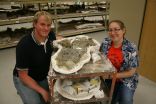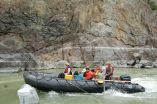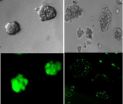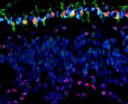(Press-News.org) The perception that Colorado's Front Range wildfires are becoming increasingly severe does not hold much water scientifically, according to a massive new study led by the University of Colorado Boulder and Humboldt State University in Arcata, Calif.
The study authors, who looked at 1.3 million acres of ponderosa pine and mixed conifer forest from Teller County west of Colorado Springs through Larimer County west and north of Fort Collins, reconstructed the timing and severity of past fires using fire-scarred trees and tree-ring data going back to the 1600s. Only 16 percent of the study area showed a shift from historically low-severity fires to severe, potential crown fires that can jump from treetop to treetop.
The idea that modern fires are larger and more severe as a result of fire suppression that allowed forest fuels to build up in the past century is still prevalent among some, said CU-Boulder geography Professor Thomas Veblen, a study co-author. "The key point here is that modern fires in these Front Range forests are not radically different from the fire severity of the region prior to any effects of fire suppression," he said.
A paper on the subject was published Sept. 24 in the journal PLOS ONE. The study was led by Associate Professor Rosemary Sherriff of Humboldt State University and involved Research Scientist Tania Schoennagel of CU-Boulder's Institute of Arctic and Alpine Research, CU-Boulder doctoral student Meredith Gartner and Associate Professor Rutherford Platt of Gettysburg College in Gettysburg, Pa.
The study was funded by the National Science Foundation.
"The common assumption is that fires are now more severe and are killing higher percentages of trees," said Sherriff, who completed her doctorate at CU-Boulder under Veblen in 2004. "Our results show that this is not the case on the Front Range except for the lowest elevation forests and woodlands."
One important new finding comes from a comparison of nine large fires that have occurred on the Front Range since 2000 -- including the 2002 Hayman Fire southwest of Denver, the 2010 Fourmile Canyon Fire west of Boulder and the 2012 High Park Fire west of Fort Collins -- with historic fire effects in the region.
"It's true that the Colorado Front Range has experienced a number of large fires recently," said Schoennagel. "While more area has burned recently compared to prior decades – with more homes coming into the line of fire – the severity of recent fires is not unprecedented when we look at fire records going back before the 1900s."
In addition, tree-ring evidence from the new study shows there were several years on the Front Range since the 1650s when there were very large, severe fires. The authors looked at more than 1,200 fire-scarred tree samples and nearly 8,000 samples of tree ages at 232 forest sample sites from Teller County to Larimer County.
The study is one of the largest of its kind ever undertaken in the western United States. The team was especially interested in fire records before about 1920, when effective fire suppression in the West began in earnest.
"In relatively dry ponderosa pine forests of the West, a common assumption is that fires were relatively frequent and of low severity, and not lethal to most large trees, prior to fuel build-up in the 20th century," said Veblen. "But our study results showed that about 70 percent of the forest study area experienced a combination of moderate and high-severity fires in which large percentages of the mature trees were killed."
Along the Front Range, especially at higher elevations, homeowners and fire managers should expect a number of high-severity fires unrelated to any kind of fire suppression and fuel build-up, said Schoennagel. "This matters because high-severity fires are dangerous to people, kill more trees and are trickier and more expensive to suppress."
"Severe fires are not new to most forests in this region," said Sherriff. "What is new is the expanded wildland-urban interface hazard to people and property and the high cost of suppressing fires for society."
In addition, a warming Colorado climate -- 2 degrees Fahrenheit since 1977 -- has become a wild card regarding future Front Range fires, according to the team. While fires are dependent on ignition sources and can be dramatically influenced by high winds, the team expects to see a substantial increase in Front Range fire activity in the low and mid-elevations in the coming years as temperatures continue to warm, a result of rising greenhouses gases in Earth's atmosphere.
INFORMATION:
Colorado's Front Range fire severity not much different than past, say CU study
Perception that present-day fires Front Range fires significantly worse than past not supported by evidence
2014-09-24
ELSE PRESS RELEASES FROM THIS DATE:
New dinosaur from New Mexico has relatives in Alberta
2014-09-24
(Edmonton) A newly discovered armoured dinosaur from New Mexico has close ties to the dinosaurs of Alberta, say University of Alberta paleontologists involved in the research.
From 76 to 66 million years ago, Alberta was home to at least five species of ankylosaurid dinosaurs, the group that includes club-tailed giants like Ankylosaurus. But fewer ankylosaurids are known from the southern parts of North America. The new species, Ziapelta sanjuanensis, was discovered in 2011 in the Bisti/De-na-zin Wilderness area of New Mexico by a team from the New Mexico Museum of Natural ...
A way to kill chemo-resistant ovarian cancer cells: Cut down its protector
2014-09-24
Ottawa, Canada – September 24, 2014 – Ovarian cancer is the most deadly gynecological cancer, claiming the lives of more than 50% of women who are diagnosed with the disease. A study involving Ottawa and Taiwan researchers, published today in the influential Proceedings of the National Academy of Sciences (PNAS), provides new insight into why ovarian cancer is often resistant to chemotherapy, as well as a potential way to improve its diagnosis and treatment.
It is estimated that 2,700 Canadian women will be diagnosed with ovarian cancer in 2014 and that 1,750 Canadian ...
Star Trekish, rafting scientists make bold discovery on Fraser River
2014-09-24
A Simon Fraser University-led team behind a new discovery has "…had the vision to go, like Star Trek, where no one has gone before: to a steep and violent bedrock canyon, with surprising results."
That comment comes from a reviewer about a truly groundbreaking study just published in the journal Nature.
Scientists studying river flow in bedrock canyons for the first time have discovered that previous conceptions of flow and incision in bedrock-rivers are wrong.
SFU geography professor Jeremy Venditti led the team of SFU, University of Ottawa and University of British ...
Bacterial 'communication system' could be used to stop and kill cancer cells, MU study finds
2014-09-24
COLUMBIA, Mo. – Cancer, while always dangerous, truly becomes life-threatening when cancer cells begin to spread to different areas throughout the body. Now, researchers at the University of Missouri have discovered that a molecule used as a communication system by bacteria can be manipulated to prevent cancer cells from spreading. Senthil Kumar, an assistant research professor and assistant director of the Comparative Oncology and Epigenetics Laboratory at the MU College of Veterinary Medicine, says this communication system can be used to "tell" cancer cells how to act, ...
Study: Biochar alters water flow to improve sand and clay
2014-09-24
As more gardeners and farmers add ground charcoal, or biochar, to soil to both boost crop yields and counter global climate change, a new study by researchers at Rice University and Colorado College could help settle the debate about one of biochar's biggest benefits -- the seemingly contradictory ability to make clay soils drain faster and sandy soils drain slower.
The study, available online this week in the journal PLOS ONE, offers the first detailed explanation for the hydrological mystery.
"Understanding the controls on water movement through biochar-amended soils ...
NASA sees the end of post-depression Fung-Wong
2014-09-24
Tropical Depression Fung-Wong looked more like a cold front on infrared satellite imagery from NASA than it did a low pressure area with a circulation.
NASA's Aqua satellite passed over Tropical Depression Fung-Wong on Sept. 23 at 12:23 a.m. EDT. The Atmospheric Infrared Sounder or AIRS instrument that flies aboard Aqua gathered infrared temperature data on the storm's clouds. The data was false-colored at NASA's Jet Propulsion Laboratory, Pasadena, California and showed that the storm resembled a frontal system more than a depression. The center of circulation was southwest ...
How a single, genetic change causes retinal tumors in young children
2014-09-24
Retinoblastoma is a childhood retinal tumor usually affecting children one to two years of age. Although rare, it is the most common malignant tumor of the eye in children. Left untreated, retinoblastoma can be fatal or result in blindness. It has also played a special role in understanding cancer, because retinoblastomas have been found to develop in response to the mutation of a single gene – the RB1 gene—demonstrating that some cells are only a step away from developing into a life-threatening malignancy.
David E. Cobrinik, MD, PhD, of The Vision Center at Children's ...
New milestone in the search for water on distant planets
2014-09-24
Astronomers have found water vapor in the atmosphere of a planet about four times bigger than Earth, in the constellation Cygnus about 124 light years - or nearly 729 trillion miles - from our home planet. In the quest to learn about planets beyond our solar system, this discovery marks the smallest planet for which scientists have been able to identify some chemical components of its atmosphere.
The researchers' findings were published Sept. 25, 2014 in the journal Nature. The team was led by University of Maryland Astronomy Professor Drake Deming, an expert in the study ...
A single statistic can strengthen public support for traffic safety laws
2014-09-24
Public support for effective road safety laws, already solid, can be strengthened by a single number: a statistic that quantifies the traffic-related injury risks associated with a given law, according to a new study from the Johns Hopkins Center for Injury Research and Policy at the Johns Hopkins Bloomberg School of Public Health.
The study, published in the September issue of Accident Analysis & Prevention, surveyed 2,397 adults nationwide about their attitudes toward four types of road-safety laws —mandatory ignition interlock installation for people convicted of driving ...
Alzheimer's patients can still feel the emotion long after the memories have vanished
2014-09-24
A new University of Iowa study further supports an inescapable message: caregivers have a profound influence—good or bad—on the emotional state of individuals with Alzheimer's disease. Patients may not remember a recent visit by a loved one or having been neglected by staff at a nursing home, but those actions can have a lasting impact on how they feel.
The findings of this study are published in the September 2014 issue of the journal Cognitive and Behavioral Neurology, and can be viewed online for free here.
UI researchers showed individuals with Alzheimer's disease ...
LAST 30 PRESS RELEASES:
Numbers in our sights affect how we perceive space
SIMJ announces global collaborative book project in commemoration of its 75th anniversary
Air pollution exposure and birth weight
Obstructive sleep apnea risk and mental health conditions among older adults
How talking slows eye movements behind the wheel
The Ceramic Society of Japan’s Oxoate Ceramics Research Association launches new international book project
Heart-brain connection: international study reveals the role of the vagus nerve in keeping the heart young
Researchers identify Rb1 as a predictive biomarker for a new therapeutic strategy in some breast cancers
Survey reveals ethical gaps slowing AI adoption in pediatric surgery
Stimulant ADHD medications work differently than thought
AI overestimates how smart people are, according to HSE economists
HSE researchers create genome-wide map of quadruplexes
Scientists boost cell "powerhouses" to burn more calories
Automatic label checking: The missing step in making reliable medical AI
Low daily alcohol intake linked to 50% heightened mouth cancer risk in India
American Meteorological Society announces Rick Spinrad as 2026 President-Elect
Biomass-based carbon capture spotlighted in newly released global climate webinar recording
Illuminating invisible nano pollutants: advanced bioimaging tracks the full journey of emerging nanoscale contaminants in living systems
How does age affect recovery from spinal cord injury?
Novel AI tool offers prognosis for patients with head and neck cancer
Fathers’ microplastic exposure tied to their children’s metabolic problems
Research validates laboratory model for studying high-grade serous ovarian cancer
SIR 2026 delivers transformative breakthroughs in minimally invasive medicine to improve patient care
Stem Cell Reports most downloaded papers of 2025 highlight the breadth and impact of stem cell research
Oxford-led study estimates NHS spends around 3% of its primary and secondary care budget on the health impacts of heat and cold in England
A researcher’s long quest leads to a smart composite breakthrough
Urban wild bees act as “microbial sensors” of city health.
New study finds where you live affects recovery after a hip fracture
Forecasting the impact of fully automated vehicle adoption on US road traffic injuries
Alcohol-related hospitalizations from 2016 to 2022
[Press-News.org] Colorado's Front Range fire severity not much different than past, say CU studyPerception that present-day fires Front Range fires significantly worse than past not supported by evidence





